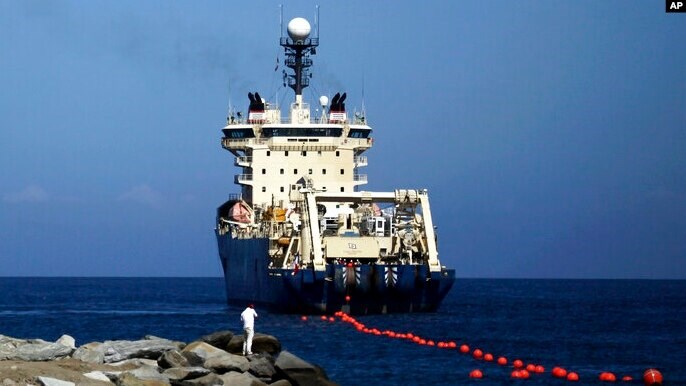US attempting to oust China from undersea internet cable network
According to a detailed examination by business media, successive US governments have deliberately worked to limit Chinese firms' engagement in the building of underwater fibre optic cables linking the globe to the internet.
-

A ship rolls out fiber-optic cable, suspended from buoys, off La Guaira along the Venezuelan coast, Jan. 22, 2011. (AP)
According to a detailed examination by business media, successive US governments have deliberately worked to limit Chinese firms' engagement in building underwater fiber optic cables, linking the globe to the Internet.
This comes amid the US national security concerns and Washington accusing China of using Chinese tech companies 'products to spy on the US, such as the infamous spy-balloon incident. China has rebuffed the claims.
The US is stopping Chinese companies from engaging in undersea internet cable projects that involve US investment by citing the potential espionage claims in addition to the possibility of Chinese-operated cables in the case of a war between the two nations.
Read more: US 'ready to fight' China, Russia in space race using military means
China has replied to US resistance by creating linkages in areas that the US, its French, and Japanese allies have not reached, such as isolated southern Chile, the Russian Far East, Southeast Asia, and a large link between South America and Africa via cables spanning from Brazil to Cameroon. Insiders in the industry report that Beijing has also tried to expand its fleet of Chinese-made cable layers and maintenance vessels, and has pressured firms whose cables pass through Chinese waterways, notably the South China Sea, to utilize HMN Tech cable, China's largest fiber optic cable provider.
Washington has aggressively enforced the 'no China' policy, to the point of leaving behind infrastructure worth "hundreds of millions of dollars" at the bottom of the sea after forcing Amazon and Meta to abandon a major cable deal with China Mobile that would have linked California to Singapore, Malaysia, and Hong Kong. It has also pressured third parties, forcing the World Bank to scrap plans to connect Pacific island nations to prevent a Chinese company from receiving the contract in 2021, and attempting to construct a massive, 19,000 km-long cable connecting East Asia to India, the Middle East, and Mediterranean countries using HMN Tech cable.
Some nations have avoided working on projects that involve Chinese cable to avoid sanctions.
Despite the remarkable progress the Asian nation has achieved in recent decades into a high-tech powerhouse, US measures have successfully limited China's internet cable-laying reach. HMN Tech now controls just one-tenth of the world's underwater cable infrastructure, while French cable giant ASN controls 41% and US-based SubCom controls 21%. That said, the US is risking a future with multiple risks, including a divided internet.
China is said to have managed to circumvent US limitations by contracting Chinese-owned and controlled vessels to repair US-owned cables. In addition, links between Chinese and US IP network providers are constantly increasing.
The world is linked by 500+ main operational and under-construction-undersea internet cables that add up to about 1.4 million km.

 3 Min Read
3 Min Read









